
Railway modelling or model railroading is a hobby in which rail transport systems are modelled at a reduced scale.

In railroad structures, and rail terminology, a wye or triangular junction is a triangular joining arrangement of three rail lines with a railroad switch at each corner connecting to each incoming line. A turning wye is a specific case.
Z scale is one of the smallest commercially available model railway scales (1:220), with a track gauge of 6.5 mm / 0.256 in. Introduced by Märklin in 1972, Z scale trains operate on 0–10 volts DC and offer the same operating characteristics as all other two-rail, direct-current, analog model railways. Locomotives can be fitted with digital decoders for independent control. Model trains, track, structures, and human/animal figures are readily available in European, North American, and Japanese styles from a variety of manufacturers.

The use of a third rail in rail transport modelling is a technique that was once applied, in order to facilitate easier wiring.
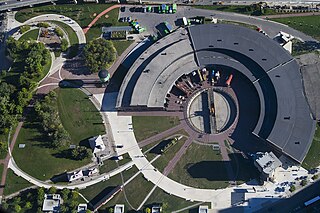
A railway roundhouse is a building with a circular or semicircular shape used by railways for servicing and storing locomotives. Traditionally, though not always the case today, these buildings surrounded or were adjacent to a turntable.

The Midland Railway – Butterley is a heritage railway at Butterley, near Ripley in Derbyshire.
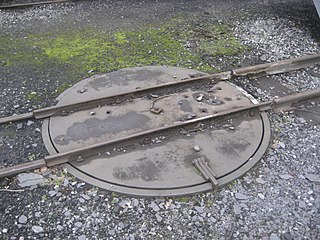
In rail terminology, a railway turntable or wheelhouse is a device for turning railway rolling stock, usually locomotives, so that they can be moved back in the direction from which they came. This is especially true in areas where economic considerations or a lack of sufficient space have served to weigh against the construction of a turnaround wye. In the case of steam locomotives, railways needed a way to turn the locomotives around for return trips as their controls were often not configured for extended periods of running in reverse and in many locomotives the top speed was lower in reverse motion. In the case of diesel locomotives, though most can be operated in either direction, they are treated as having "front ends" and "rear ends". When operated as a single unit, the railway company often prefers, or requires, that a diesel locomotive is run "front end" first. When operated as part of a multiple unit locomotive consist, the locomotives can be arranged so that the consist can be operated "front end first" no matter which direction the consist is pointed. Turntables were also used to turn observation cars so that their windowed lounge ends faced toward the rear of the train.
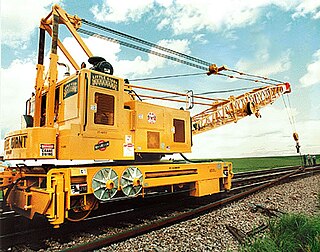
A railroad crane is a type of crane used on a railroad for one of three primary purposes: freight handling in goods yards, permanent way (PW) maintenance, and accident recovery work. Although the design differs according to the type of work, the basic configuration is similar in all cases: a rotating crane body is mounted on a sturdy chassis fitted with flanged wheels. The body supports the jib and provides all the lifting and operating mechanisms; on larger cranes, an operator's cabin is usually provided. The chassis is fitted with buffing (UK) and/or coupling gear to allow the crane to be moved by a locomotive, although many are also self-propelled to allow limited movement about a work site.

A rail yard, railway yard, or railroad yard is a complex series of railroad tracks for storing, sorting, or loading and unloading railroad cars and locomotives. Railroad yards have many tracks in parallel for keeping rolling stock or unused locomotives stored off the mainline, so that they do not obstruct the flow of traffic. Railroad cars are moved around by specially designed yard switchers, a type of locomotive. Cars in a railroad yard may be sorted by numerous categories, including railway company, loaded or unloaded, destination, car type, or whether they need repairs. Railroad yards are normally built where there is a need to store cars while they are not being loaded or unloaded, or are waiting to be assembled into trains. Large yards may have a tower to control operations.

A transfer table or traverser is a piece of railway equipment. It functions similarly to a turntable, although it cannot be used to turn vehicles around.

In model railroading, a layout is a diorama containing scale track for operating trains. The size of a layout varies, from small shelf-top designs to ones that fill entire rooms, basements, or whole buildings.

Thomas & Friends merchandise has been produced to capitalize on the success of the television series Thomas & Friends. Whilst merchandise was produced alongside due to the popularity of the first of The Railway Series by the Rev. W. Awdry since 1945, and the original broadcast of the television series in 1984 in the United Kingdom, large numbers of manufacturers have sought to produce Thomas-branded items after the television series was broadcast in America and Japan.
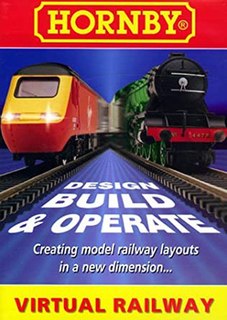
Hornby Virtual Railway is a video game and model planning environment released for Microsoft Windows in 1996.

The Los Angeles Live Steamers Railroad Museum (LALSRM) is a non-profit public-benefit corporation founded in 1956 by live steam enthusiasts for the purpose of educating the public about railroad history and lore, and to promote live steam and scale model railroad technology. The museum is located in Griffith Park in Los Angeles, California and is open from 11 a.m. to 3 p.m. every Sunday weather permitting. In 1956, all of the model locomotives were steam-powered, hence the name "Live Steamers". Over the years, gasoline-powered models of diesel locomotives and battery-electric locomotives and trolleys have also become popular. The museum operates a 7+1⁄2 in gauge miniature railway on which these locomotives pull trains that the public can ride.
Cyril John Freezer was an English railway modeller, writer, and magazine editor. He edited Railway Modeller from 1950 to 1978, and Model Railways from 1978 until 1983. He also wrote many articles for Model Railroader. Freezer popularised the 'terminus to fiddle yard layout', is credited with inventing the "rabbit warren layout", and published many books on model railways, many of which are considered classics in the field.
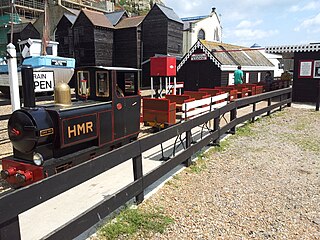
The Hastings Miniature Railway is a 10+1⁄4 in gauge miniature railway located on the seafront at Hastings, a seaside resort, town, and ancient cinque port, in East Sussex, England. Opened in 1948, it remains a popular tourist attraction. The line was re-opened in the summer of 2011 after a period of reconstruction and restoration, which coincided with a forced closure of the eastern part of the line, to facilitate building work on a new art gallery adjacent to the railway.
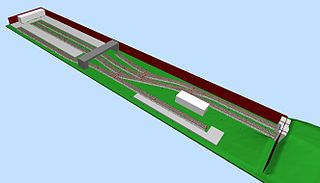
Minories is a 'deceptively simple' design for a model railway layout, designed by C. J. Freezer. The design was first published in Railway Modeller in 1957 and it became a regular of Peco's many collected plans books afterwards. It is notable as an influential design, more than as a single instance of the model. The design was an attempt to model an interesting urban passenger terminus in the minimum space, allowing much opportunity for operating trains, rather than scenic modelling. Freezer was the editor of Railway Modeller and Minories, with its developments, made regular appearances throughout the years.

A rabbit warren layout is a model railway layout. A group of designs, more than a single constructed layout, rabbit warrens provide a humorous display of continuously moving trains that appear to pop in and out of tunnels, seemingly randomly.

A pizza layout is a model railway laid out as a circle of the smallest workable radius of curve, on the smallest possible square or circular baseboard. This baseboard can be so small as to look as if it would fit into a pizza box, hence the name.

















